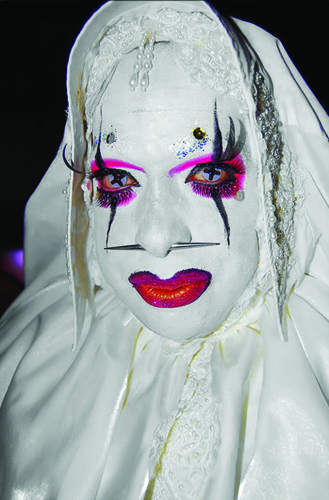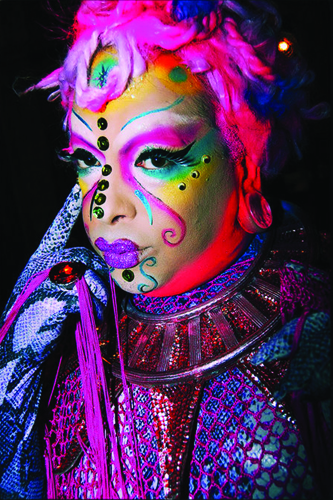An Interview with JoJo Baby at Wicker Park’s FlatIron Building
By Jeremy Stephen Shedd
Images courtesy of the artist
 The yapping sounds of two small dogs resound as I enter JoJo’s Closet, the gallery owned by artist and performer JoJo Baby at the Flatiron Building in Wicker Park. I walk past a large pile of Raggedy Anne dolls as JoJo greets me and hushes his two Chihuahuas, Sir Lefty and Venus, who quiet down after the artist and I sit down in his workroom. In addition to past work and unfinished projects, I find myself in the midst of an impressive collection of colorful Muppets and Baroque trinkets. Nearby, JoJo keeps a collection of dome-shaped glass terrariums housing the molds of assorted erections, which engendered the series of plaster phalluses lining the windowpane in his workroom.
The yapping sounds of two small dogs resound as I enter JoJo’s Closet, the gallery owned by artist and performer JoJo Baby at the Flatiron Building in Wicker Park. I walk past a large pile of Raggedy Anne dolls as JoJo greets me and hushes his two Chihuahuas, Sir Lefty and Venus, who quiet down after the artist and I sit down in his workroom. In addition to past work and unfinished projects, I find myself in the midst of an impressive collection of colorful Muppets and Baroque trinkets. Nearby, JoJo keeps a collection of dome-shaped glass terrariums housing the molds of assorted erections, which engendered the series of plaster phalluses lining the windowpane in his workroom.
It’s probably safe to say that JoJo Baby is one of the most fascinating people you’ve never heard of. A veteran of the drag performance circuit and a practicing visual artist, JoJo has only just achieved a widespread fame of sorts following the November premier of a documentary about his life and work, “JoJo Baby,” produced by Clive Barker. JoJo agreed to chat with F Newsmagazine to discuss how this sudden popularity is affecting him and his practice.
I asked JoJo how things have changed for him since the movie. “Clive Barker really just let me be myself while the documentary was shot,” he responded. “Nothing’s really changed just yet. I’m still the same old Jo. As my mother used to tell other people, I’m a good kid that just dresses funny.
“But my friends do seem to see me differently now that they know my whole story. One of my friends couldn’t even look me in the eye after watching the premiere of the documentary because he’d had no idea what I had been through. But I don’t want people to feel bad.”
Even if JoJo feels nothing’s changed, there’s at least been a surge of media interest; journalists interrupt our chat with phone calls requesting interviews, to which JoJo sighs, “There’s no rest for the wicked.”
But that media interest has yet to turn into an interest from the market. Though JoJo has been living and working at the Flatiron Building for over ten years now, a few weeks ago his landlord moved him and his belongings from his more prominent place overlooking the six-corner intersection of Milwaukee, North, and Damen to this more remote space in the back of the building. His landlord says his work is not commercially viable enough to occupy the more prominent locale.
 In terms of his artistic practice, it may be best to describe JoJo as a doll maker. Using found materials and other items donated by friends, such as fabric, human hair, and teeth, JoJo creates objects that are as unique as he is, and that carry a profoundly sentimental value exceeding their constitutive materials. Each doll’s innards include a heart, a written message, and wires resembling veins that aren’t even visible once each doll is complete.
In terms of his artistic practice, it may be best to describe JoJo as a doll maker. Using found materials and other items donated by friends, such as fabric, human hair, and teeth, JoJo creates objects that are as unique as he is, and that carry a profoundly sentimental value exceeding their constitutive materials. Each doll’s innards include a heart, a written message, and wires resembling veins that aren’t even visible once each doll is complete.
The dolls prove that “everything can have a second or third life,” JoJo says, and it seems the dolls underpin different elements of his personality, to the extent that he has a hard time letting go of them. “There are certain dolls I’ve made and sold that I wish I could purchase back,” he says. “How can I sell a friend?”
Of course, this Chicago native is perhaps better known for his performances; and just like his dolls, each of JoJo Baby’s drag personas, wigs, and shoes are made entirely by hand. As a performer, JoJo cites Pete Burns, Jim Henson, and Boy George among his biggest influences. “These are people who are unafraid to be themselves, and they were always doing something,” he explains.
Now 39, the artist got his start on the drag circuit when he was 13. JoJo’s mother, a former Playboy Bunny, was a constant source of support and inspiration for him throughout his childhood; she taught him how to sew and apply makeup like a professional while he was still in grade school. “My mother gave me the nickname ‘JoJo Baby’ while I was little,” he says. “It is something I’ve always kept with me.”
“I was definitely shaped by bullying growing up,” the artist recalls; kids often hurled insults at him due to the way he dressed. “But I believe in God and always want to fight for the light.”
As part of that fight, JoJo struck out on his own at age 14, leaving home due to an abusive relationship with his alcoholic father, and enrolled in beauty school. He’s performed in Chicago’s club scene ever since.
Currently, JoJo performs in drag on Monday nights at the Green Dolphin in Bucktown. But that’s not the only time he can be found in costume. “I dress up every day in my head,” JoJo says, and although it takes a lot of time and resources, “I always dress according to how I feel. … Sometimes I feel empty, sometimes I feel beautiful, sometimes I feel like a monster … but mostly I just feel alone.”
“When I feel ugly on the inside, I show it on the outside. On the nights that I feel beautiful, I want everyone to know it. I’ve been incorporating an element in my costumes lately that looks like a piece of my makeup is peeled away from my face revealing my actual skin around one my eyes. This shows people how I’m still myself even behind what people may think is a disguise.”
JoJo goes on to describe how “a few years ago my boyfriend beat me up so badly that my lips were really swollen for a couple days. I still went out to perform though and everyone thought my lips were the best prosthetics they’d ever seen. I just let them believe they were fake.”
For JoJo, dressing up is a self-empowering means of externalizing what he feels inside. Whether he dresses like a monster or a beauty queen, he is always empowered by the transformation; he embodies the sincerity of a disenfranchised person who eloquently pieces together the shards of a fractured identity into the form of the dolls and the personas he creates and shares with the public.
I ask JoJo what he sees for himself in the near future, and he’s optimistic, in spite of losing his mother, his job, his boyfriend, and being diagnosed with HIV back in 2005.
“I expect to have to dress in drag more often since the release of this documentary,” he says. “People tend to dub me as just another Lady Gaga impersonator, but I’ve been dressing and performing long before she even got started. I like her performances and her music, but I’d still love to give her a run for her money. … I’d eventually like to own a house that would become art itself, and I’d also like to have my own makeup line.”
“I do wonder, though, if anyone will ever love me again, since I have HIV,” he concludes wistfully.
Though fame may be a driving force in JoJo’s career, it clearly takes a back seat to his need to share his story with others and impact their lives for the better. Though he may feel he only has himself to depend on these days, both anger and regret are entirely absent from his explanation of his life and story. JoJo’s honest humility is evident in our exchange. “I wanted to meet with you because you never know who will read your article,” he tells me, “and how it might impact someone else.” And as our interview winds to a close, JoJo is regretful to say goodbye: “I am always sad to see people leave my gallery.”
Despite his losses, JoJo maintains an admirable honesty about his priorities. Particularly relevant in the aftermath of the recent trend in gay teenage suicides, his story speaks to the power of optimism in the face of adversity.






